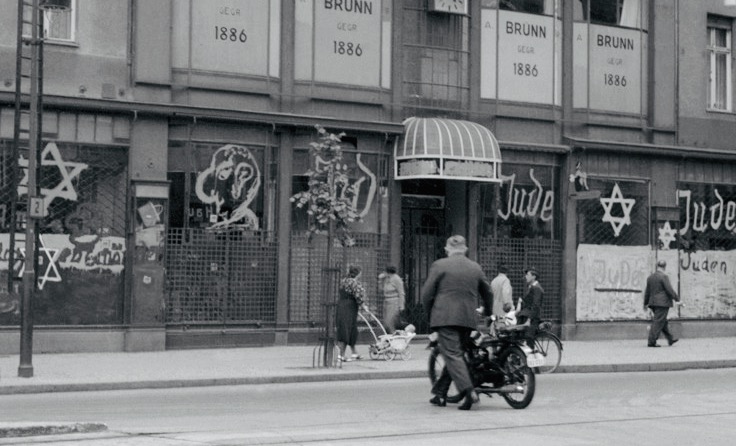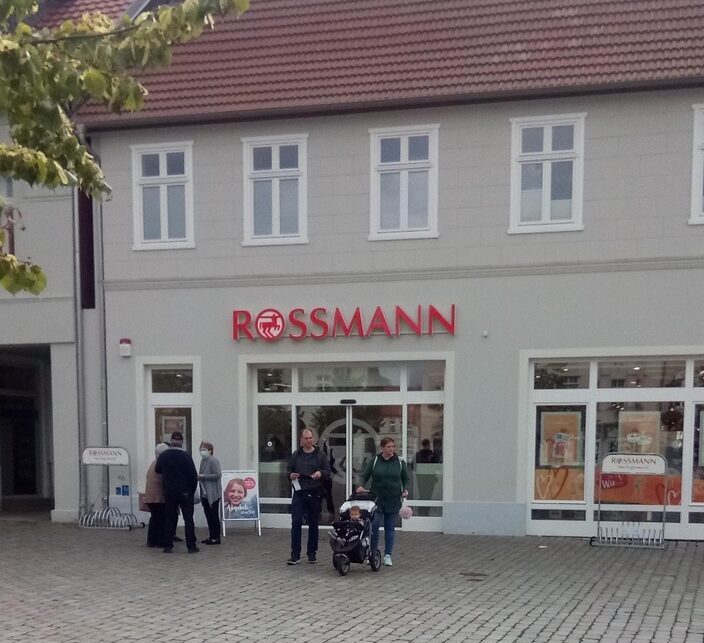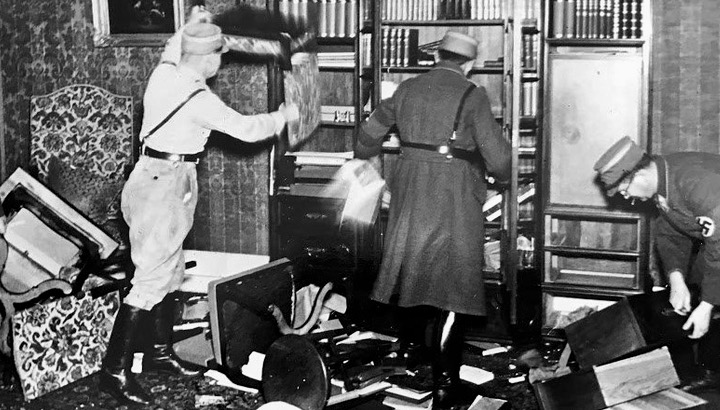
Last fall I received a flyer from Amilie, my friend in Berlin, as a reminder that the 9th of November is the day to commemorate Kristallnacht. One could also consider it the beginning of the Holocaust.
It is Amelie who continues to be an incredible source of historical information about my family and my relatives.
In keeping with the 80th anniversary of that horrendous night, the flyer she sent was focused specifically on its observation in the small town of Wittstock, which was also celebrating the placing of the memorial stones, called “Stolpersteine” or stumbling stones, in memory of the Jewish residence there who were victims of the Holocaust.

The Stolpersteine event was started in Wittstock in 2014 by its creator the artist, Gunter Demnig, thanks to donations from the town’s residents. That’s when he laid five stones in front of two addresses that fronted on the town’s market street. Three of the stones had been prepared and placed at #6 Market Platz, in memory of three members of the Mendelsohn family, who lived there. And the other two were for Hedwig Rehfisch, wife of Albert Rehfisch, my mother’s uncle, and their son, Gerhard. Their stones were placed at #10 Market Platz, where they had lived and worked.
They also happened to be the only two remaining Jewish families in Wittstock and the time.
But it turned out that the flyer had even more significance than I thought at first glance. That’s because it also contained new and valuable information about the Rehfisch family, much of it based on direct testimony from Albert’s wife, Hedwig, which revealed what actually happened to them on the 9th of November, 1938, “The Night of the Broken Glass”!

But first, a little orientation and history…
With the Nazis in power since 1933, by 1938 the atmosphere in the village was pretty grim even though few Jews remained. Anyone who worked for a Jew or bought from them would “suffer severe consequences!”
As an example, there was a report that a Herr Siegfried, who continued to buy goods from the Jews, ended up deported to the Sachsenhausen concentration camp; a pretty severe consequence.
Although there were no more Jewish children of school age in Wittstock, those in the surrounding towns and villages were no longer welcome in their former schools and were forced to stay at home.
Meanwhile, many of the non-Jewish store owners in Wittstock were quite “out front” about their policy, by posting signs that said, “We do not sell to Jews”.
By the first of November, as if in anticipation of the coming “pogrom”, those few remaining Jewish shops had become vandalized and smeared with anti-Semitic slogans.
In stark contrast, when times were more peaceful, the original owner of the little shop at #10 Market Platz was described as a small, friendly man, who could often be found standing outside the front of his store, greeting shoppers while observing the activity going on in the rest of the market- place. That was my grand uncle, Albert Rehfisch,
But Albert died in 1936, long before Kristallnacht’, when all the “Jew hating” came to such a boiling point.

The Rehfisch family had always lived above their store at #10 Market Platz, in a small five room apartment that fronted on the street. When Albert died he left it to his son, Gerhard, while the business portion remained with Hedwig who, along with Gerhard, continued to run their business. They lived together in the apartment along with Gerhard’s wife, Selma.
Unfortunately many records in Wittstock were destroyed during the war. But thankfully we’re still able to piece together much of what happened that night through the eyes and words of Hedwig Rehfisch.

That night, November 9, 1938, Hedwig was in their small apartment doing the dishes, while Gerhard was in their living room, working on his business ledger, and Selma was busy writing letters to her relatives back in Wongrowitz, Posen.
Suddenly there was a loud banging on the door. But before any of them could reach it, six armed Nazi Brown Shirts burst in yelling obscenities at them. And then quickly began tearing up furniture and ripping pictures off the walls.
The Brown Shirts were part of the SA, the Sturmabtielung. A paramilitary group that was inhabited by strong armed thugs who made up that wing of the Nazi party, in contrast to the party’s elite, the SS corps.

Frozen in horror, Hedwig, Gerhard and Selma could only watch as the Nazis continued to destroy their family treasures. Two of the Brown Shirts grabbed hands full of books and began throwing them out the windows. And then they even picked up the bookcase itself, tore it apart and threw it out in pieces.
After all the books had been summarily dumped out of the apartment’s windows, they were soon followed by other pieces of broken furniture and pottery..
Then two of the thugs began ransacking the clothes closets, tossing armloads of garments out the windows along with torn up bed sheets and pillow cases.
Meanwhile, on the street below the Nazis had already started a huge bonfire fueled by the piles of burning books in front of the two apartments. Urged on by the “Jew hating” supporters who came out to view the festivities, some began scavenging for whatever items of value that they could find, like pieces of jewelry, or a treasured family heirloom. The trick was to spot it and then retrieve it before it was cremated in the burning caldron.

Others, who weren’t necessarily Nazi sympathizers were also part of the crowd, but were better described as merely curious onlookers.
The next day Hedwig and her family were arrested and put in “protective custody in the city jail in Wittstock’s courthouse.
But in her description, the word she used – “Schutzhäftling” – translates into “protective custody”. But it really has no English equivalent and actually reverses the meaning as we know it, “to protect the prisoner”. “Schutzhäftling” actually means to protect the German Reich from the prisoner. In this case the Jews since all Jews were now considered enemies of the state.

And what an incredible danger to the Nazis Hedwig, Gerhard and Selma must have been!!! (The sarcasm is all mine.)
In her filing for reparations it was also revealed that in the weeks before the Pogrom, Hedwig realized that she had little choice but to sell the family’s holdings while she was still able to get some value for them. So she turned to a non-Jewish acquaintance and businessman by the name of Herr Krell, who lived nearby in the town of Wittenberg. After a long negotiation they agreed on a price, and had the entire contract registered by a notary in Wittstock, which officially turned the ownership of the family’s store, its contents, and their small warehouse over to Krell.
But shortly after she was jailed, she was visited by two officials from the mayor’s office: Herr Krueger, and Herr Hoffmann, along with the city’s notary Herr Kuekenthal. They came to “advise” her that her sale to Herr Krell was invalid because he was not recognized as being in good standing with the Nazis and consequently could not buy anything from a Jew. Or in this case, a Jewess.
Now as an “enemy of the Reich”, Hedwig was essentially sandbagged into selling her property all over again. But this time to Herr Krueger, who offered her a fraction of what Krell, the former buyer, had promised to pay. Yet there was nothing else she could do now but accept his offer for a mere pittance of its true value.
Meanwhile, within days of their incarceration, Gerhard, and their next door neighbor, Erich Mendelsohn, who had also been arrested and jailed with his family, were moved to the notorious Sachsenhausen concentration camp, where they remained for nearly a month.
But the Nazis had also given Hedwig a way out in the form of an ultimatum. “Your son will remain a prisoner in Sachsenhausen unless all of you leave Germany NOW or face the consequences!”.
Whether it was before or while she was in prison, Hedwig had learned that the only place in the world that would take them as Jewish refugees, without entry visas, was Shanghai, China. And somehow she commandeered three exit visas, because within a week’s time she was able to gain Gerhard’s release from the concentration camp and still get the three of them on a ship bound for Shanghai.

Looking back on what other Jews had to go through to escape from Germany, Hedwig pulled off a miracle. But their freedom didn’t come cheap because in the end, the Nazis had disenfranchised them, threatened them physically and psychologically, and had robbed them of their home and all their belongings, while leaving them stateless. Plus their departure visas must have cost them dearly.
Now the story shifts to Shanghai as a postscript, and where the culture shock must have been horrific. I know through friends who were also Shanghai refugees, that most of them had to adjust to living conditions that were so grim that multiple families found themselves living together in a single room, with the only toilet a communal bucket that had to be dumped periodically in the alley outside.
Gerhard was already in poor health when they arrived in Shanghai, and didn’t respond well to these conditions. His health had already deteriorated by the time he was released from Sachsenhausen. That combined with rigors of the journey and the poor living conditions in Shanghai, he hung on for a year and a half, but finally succumbed to a heart attack on August 12, 1940.

The next recorded event came almost three years later when Selma remarried another German/Jewish refugee in Shanghai. His name was Alfred Jacoby.
Curiously, and for whatever reason, whether it was Selma’s remarriage or something else, Hedwig never forgave her, because as the only person in the family to chronicle what took place during that period, Hedwig never ever mentions Selma in any of her correspondence!!!
In 1947, two years after the war with Japan ended, Hedwig emigrated to San Francisco, arriving there on August 25, . And so did Selma with her new husband. But they arrived in San Francisco three months earlier, and immediately moved up to Seattle, Washington
On April 12, 1948, Hedwig wrote the incredible document, without which there would have been little personal information to be found about events surrounding Kristallnacht in Wittstock. The letter was addressed from the San Francisco “Victims of Fascism Department” to the District Office in Kyritz (Ostprignitz) – of which Wittstock was a part. The letter presented her case in which she hoped to gain compensation, at least for a small portion of what she lost when forced to sell her property before she fled to Shanghai.
Without her words, we would never have known what happened to her and Gerhard during the Pogrom of November, 1938. Yet sadly, it is doubtful that she ever received any reparations for her losses.
A short time later Hedwig left San Francisco and moved across the country to the New York City suburb of Kew Gardens, moving in with her brother in law, Bernard Rehfisch and his wife, Elfriede. They were also Shanghai refugees.
As it turned out Kew Gardens and other nearby suburbs became a post war sanctuary for many of my relatives after the war. Hedwig remained there until she died, on October 16, 1957. She was 81 years old.

Dear Pete,
Thank you so much for including me in your mailing . My goodness What A Story and to think they ae related to you. This pandemic is scary and so many have died the world over, but it doesn’t compare to the horror of what went on in the 1930’s – carried out by humans. There are so very few left now who were there and can tell the story.
Once again there is so much hate of Jewish people – but we will be strong and survive!
May you stay safe and be well
Muriel
Muriel, thanks as always. Your support is greatly appreciated.